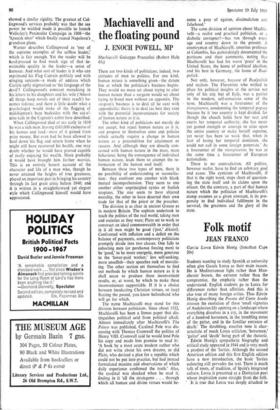Folk motif
JEAN FRANCO
Garcia Lorca Edwin Honig (Jonathan Cape 30s) Students wanting to study Spanish at university often give Garcia Lorca as their main reason. He is Mediterranean light rather than Man- chester brown, the extreme rather than the compromise, the emphatic rather than the understated. English students go to Lorca for differences rather than affinities. And this is also true of many foreign critics. Thus Edwin Honig describing the Poema del Cante Tondo stresses the exoticism of these 'small vignettes of Andalusian life opening on a landscape where everything dissolves in a cry, in the movement of a hundred horsemen, in the trembling notes of the guitar, and in the familiar entrance of death.' The throbbing, emotive tone is char- acteristic of much Lorca criticism, 'horsemen,' 'guitar' and 'death' being part of the rhetoric.
Edwin Honig's sympathetic biography and critical study appeared in 1944 and is very much a product of the 'forties. Although the second American edition and this first English edition have a new introduction, the basic 'forties colouring still pervades the text. There is much talk of roots, of tradition, of Spain's integrated culture. Lorca is presented as a Dionysian poet whose inspiration came straight from the folk. ' It is true that Lorca was deeply attached to i; native province of Granada, though whether shared Mr Honig's view that it was an 'open- paradise' is another matter. It is also true ,3t his first publications (Libro de poemas, ,21 and Canciones, 1927) reveal a great in- 'est in folk forms and rhythms but it was an 1:erest comparable to that of a Bartok or a lanuel de Falla and possibly dictated by his :)y love of music rather than by any mystique bout the folk. Before the publication of his onancero gitano (1928), which was a series of Iliad poems on gipsy themes, he was well flown for his recitals of poetry. All through is life, indeed, he seems to have been intensely incerned with removing poetry from the nted page and making it into one of the per- rrning arts. The theatre was the proper place his talent as he was to discover, not only -cause of his interest in performance but also 'cause he had a tragic conflict to express. The ,inflict was not so much the one which Mr ionig suggests, between healthy primitive socie- ei and sick industrial ones, as one within e individual between the libido and self- Aructive tendencies, between Eros and hmatos.
The conflict is already central to the Roman- ro gitano, although the gipsy characters and e ballad forms gave these poems a speciously Ii character. To Lorca's dismay these poems coned him a reputation as a 'poet of the gipsies' lien in fact the gipsies were as much literary ices as Alberti's 'angels.' And it was partly a mood of depression after the publication of Romancer°, that he made his decisive trip New York in 1929.
New York was not simply a foreign interlude some-critics believe but an experience that reed him- to make a violent but vital break '11 inadequate rhetoric. And the poems of oeta en Nueva York are not simply chaotic berrations but apocalyptic visions of total lienation from nature and the triumph of lanatos. In New York his awareness of the tic conflict was deepened, his technical re- lurces amplified. On his return to Spain, he dblished his best poem, Lament for Ignacio 'flchez Mejias, 1935, an exploration into the aning of death, the decay of the body, the .organisation of the personality and the agility of memory.
Raymond Williams does not mention Lorca's me in his book, Modern Tragedy, yet surely Spanish: author's preoccupation with violence nd self-destruction should have earned him a ace alongside Eugene O'Neill. The fact that heroines of Blood Wedding, Yerma and he House of Bernarda Alba are peasants is cidental. In Blood Wedding there are still ements of folksy picturesqueness but these we quite disappeared from his last tragedies hich are stark to the point of abstraction. rnarda Alba's house is both womb and pulchre; the destruction of her own daughter -es place entirely within its walls, for the bio- 2ical tragedy is a private one. It was Roland erthes who suggested that the Racinian hero as an imprisoned man who could only escape o death. The parallel with the characters in he House of Bernarda Alba is a striking one. ertainly it would be interesting to see this play "en the imaginative production it deserves. Lorca's early, violent death was a tragedy in ny senses and not least because it destroyed at a moment when he seemed able to be- rne one of the world's great dramatists. It is talising that his unfinished El ptiblico (The udience) still remains unpublished. Perhaps pages will eventually reveal to us a Lorca at we did not know.







































 Previous page
Previous page